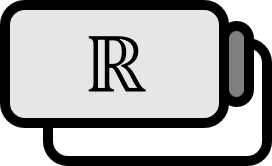The Euler Constant e is an Irrational Number
Theorem
$\mathbb{Q}$ represents the set of rational numbers.
Proof
Using Maclaurin Expansion1
Strategy: Split $e^{-1}$ into two parts using the Maclaurin expansion and derive a contradiction. This proof cannot be conducted within the high school curriculum due to the necessity of the Maclaurin expansion.
$\mathbb{N}$ represents the set of natural numbers, $\mathbb{Z}$ represents the set of integers.
Part 1. $x_{1} = x_{2}$
Assuming $e \in \mathbb{Q}$, the Euler’s constant $e$ must be representable as $e = {{ a } \over {b}}$ for some $a,b \in \mathbb{N}$. By the Maclaurin expansion of the exponential function,
$$ e^{-1} = {{ b } \over { a }} = \sum_{k=0}^{\infty} {{ (-1)^{k} } \over { k! }} $$
Multiplying both sides by $(-1)^{a+1} a!$ and swapping their positions,
$$ \sum_{k=0}^{\infty} {{ (-1)^{k + a + 1} a! } \over { k! }} = b (-1)^{a+1} ( a - 1 )! $$
If the sigma on the left side starts at $k=a+1$, then $\sum_{k=1}^{a} {{ (-1)^{k + a + 1} a! } \over { k! }}$ is missing from the right side, $$ \sum_{k=a+1}^{\infty} {{ (-1)^{k + a + 1} a! } \over { k! }} = b (-1)^{a+1} ( a - 1 )! - \sum_{k=1}^{a} {{ (-1)^{k + a + 1} a! } \over { k! }} $$ Now, if we let the left side be $x_{1}$ and the right side $x_{2}$, obviously $x_{1} = x_{2}$ will hold. $$ x_{1} := \sum_{k=a+1}^{\infty} {{ (-1)^{k + a + 1} a! } \over { k! }} $$
$$ x_{2} := b (-1)^{a+1} ( a - 1 )! - \sum_{k=1}^{a} {{ (-1)^{k + a + 1} a! } \over { k! }} $$
Part 2. $x_{1} \in (0,1)$
Directly expanding $x_{1}$,
$$ x_{1} = {{ 1 } \over { a+1 }} - {{ 1 } \over { (a+1)(a+2) }} + {{ 1 } \over { (a+1)(a+2)(a+3) }} - \cdots $$ As $k$ increases, $\left| (-1)^{k+a+1} {{ a! } \over { k! }} \right|$ decreases, hence $x_{1}$ must be larger than ${{ 1 } \over { a+1 }}$ and smaller than ${{ 1 } \over { a+1 }} - {{ 1 } \over { (a+1)(a+2) }}$. Therefore, $x_{1}$ must be some number between $0$ and $1$.
Part 3. $x_{2} \in \mathbb{Z}$
If $k \le a$ then ${{ a! } \over { k! }}$ is a natural number, upon simplification,
$$ x_{1} \in (0,1) $$
$$ x_{2} \in \mathbb{Z} $$
However, since $(0,1) \cap \mathbb{Z} = \emptyset$, it means $x_{1} \ne x_{2}$, but it was clearly $x_{1} = x_{2}$ in Part 1, which is a contradiction.
■
Using the Definition of $e$2
Definition of Euler’s constant
$$ e: = \sum \limits_{n=0}^{\infty} \dfrac{1}{n!} $$
If we call $s_{n}$ the partial sum of $e$, then by the definition of $e$, it follows:
$$ \begin{align*} e - s_{n} =& \dfrac{1}{(n+1)!} + \dfrac{1}{(n+2)!} + \dfrac{1}{(n+3)!} + \cdots \\ &< \dfrac{1}{(n+1)!} + \dfrac{1}{(n+1)!(n+1)} + \dfrac{1}{(n+1)!(n+1)^{2}} + \cdots \\ =& \dfrac{1}{(n+1)!}\left( 1 + \dfrac{1}{(n+1)} + \dfrac{1}{(n+1)^{2}} + \cdots\right) \\ =& \dfrac{1}{(n+1)!}\left( \dfrac{n+1}{n} \right) \\ =& \dfrac{1}{n! n} \end{align*} $$
Now, let’s assume that $e$ is rational. Then there exists a positive integer $p, q$ that satisfies $e=\dfrac{p}{q}$, and accordingly:
$$ 0 < q!(e - s_{q}) < \dfrac{1}{q} $$
By assumption, $q!e=(q-1)!p$ is an integer. And,
$$ q! s_{q} = q! \left( 1 + 1 + \dfrac{1}{2!} + \cdots + \dfrac{1}{q!} \right) $$
so $q!s_{q}$ is also an integer. Therefore, $q!(e-s_{q})$ is an integer, but since $q\ge 1$, $q!(e-s_{q})$ ends up being an integer between $0$ and $1$, which is a contradiction. Hence, the assumption is wrong, and by proof by contradiction, $e$ is irrational.
■
